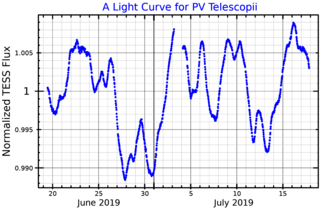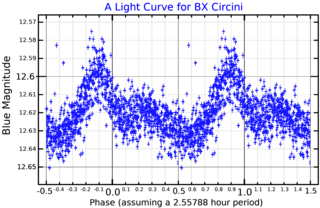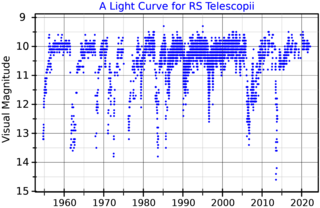
Telescopium is a minor constellation in the southern celestial hemisphere, one of twelve named in the 18th century by French astronomer Nicolas-Louis de Lacaille and one of several depicting scientific instruments. Its name is a Latinized form of the Greek word for telescope. Telescopium was later much reduced in size by Francis Baily and Benjamin Gould.

Supergiants are among the most massive and most luminous stars. Supergiant stars occupy the top region of the Hertzsprung–Russell diagram with absolute visual magnitudes between about −3 and −8. The temperature range of supergiant stars spans from about 3,400 K to over 20,000 K.

R Coronae Borealis is a low-mass yellow supergiant star in the constellation of Corona Borealis. It is the prototype of the R Cor Bor class of variable stars, which fade by several magnitudes at irregular intervals. R Coronae Borealis itself normally shines at approximately magnitude 6, just about visible to the naked eye, but at intervals of several months to many years fades to as faint as 15th magnitude. Over successive months it then gradually returns to its normal brightness, giving it the nickname "reverse nova", after the more common type of star which rapidly increases in brightness before fading.

Chi Cygni is a Mira variable star in the constellation Cygnus, and also an S-type star. It is around 500 light years away.

Upsilon Sagittarii is a spectroscopic binary star system in the constellation Sagittarius. Upsilon Sagittarii is the prototypical hydrogen-deficient binary (HdB), and one of only four such systems known. The unusual spectrum of hydrogen-deficient binaries has made stellar classification of Upsilon Sagittarii difficult.

RV Tauri variables are luminous variable stars that have distinctive light variations with alternating deep and shallow minima.

Alpha Telescopii, Latinized from α Telescopii, is the brightest star in the southern constellation of Telescopium, with an apparent visual magnitude of 3.5. The ancient Roman astronomer Ptolemy included it in the constellation Corona Australis, but it was moved to Telescopium when that constellation was created by French astronomer Nicolas Louis de Lacaille in the 18th century. Parallax measurements put it at a distance of 278 light-years from Earth. At that range, the visual magnitude of the star is diminished by an extinction of 0.22 due to interstellar dust.
λ Telescopii, Latinized as Lambda Telescopii, is a solitary, white-hued star in the southern constellation of Telescopium. It is visible to the naked eye as a faint point of light with an apparent magnitude of +4.87. This body is located approximately 610 light years from the Sun based on parallax. At that distance, the visual magnitude of the star is diminished by an extinction of 0.18 due to interstellar dust.

Nu Telescopii, Latinized from ν Telescopii, is a slightly evolved star in the southern constellation Telescopium. It has an apparent visual magnitude of 5.33, allowing it to be faintly visible to the naked eye. The object is relatively close at a distance of 169 light years but is approaching the Solar System with a heliocentric radial velocity of about −12 km/s.

HD 125823, also known as V761 Centauri or a Centauri, is a variable star in the constellation Centaurus. It is a blue-white star that is visible to the naked eye with a mean apparent visual magnitude of +4.41. The distance to this star is approximately 460 light years based on parallax measurements. It is a member of the Upper Centaurus–Lupus subgroup of the Scorpius–Centaurus association.

IQ Aurigae is a single, variable star in the northern constellation of Auriga. It is visible to the naked eye as a dim, white-hued star with an apparent visual magnitude that fluctuates around 5.38. The star is located at a distance of about 460 light-years from the Sun based on parallax and is drifting further away with a radial velocity of +28.6 km/s.
A helium star is a class O or B star (blue), which has extraordinarily strong helium lines and weaker than normal hydrogen lines, indicating strong stellar winds and a mass loss of the outer envelope. Extreme helium stars (EHe) entirely lack hydrogen in their spectra. Pure helium stars lie on or near a helium main sequence, analogous to the main sequence formed by the more common hydrogen stars.
An extreme helium star is a low-mass supergiant that is almost devoid of hydrogen, the most common chemical element of the Universe. Since there are no known conditions where stars devoid of hydrogen can be formed from molecular clouds, it is theorized that they are the product of the mergers of helium-core and carbon-oxygen core white dwarfs.

PV Telescopii, also known as HD 168476, is a variable star in the southern constellation of Telescopium. It is too dim to be visible to the naked eye, having an apparent visual magnitude that has been measured varying from 9.24 down to 9.40. The star is the prototype of a class of objects called PV Telescopii variables. It is located at an estimated distance of approximately 23 kilolight-years from the Sun, but is drifting closer with a radial velocity of −169 km/s.

BX Circini is a star in the constellation Circinus. Its variability was discovered in 1995, with its apparent magnitude ranging from 12.57 to 12.62 over a period of 2 hours 33 minutes. It is currently classified as a PV Telescopii variable star, but has been put forward as the prototype of a new class of pulsating star—the BX Circini variables—along with the only other known example, V652 Herculis. This class of star is rare, possibly because this is a brief stage of stellar evolution. Its mass has been calculated to be around 40 percent that of the Sun, but the radius is a few times larger than that of the Sun. The average surface temperature is high, and has been measured at 23,390 ± 90 K using optical spectra, but 1750 K cooler if analysing it in both the visual and ultraviolet. The temperature appears to vary by 3450 K.

RS Telescopii, abbreviated RS Tel, is a variable star in the southern constellation of Telescopium. It is a dim star with an apparent visual magnitude of 10.67, which is much too faint to be visible without a telescope. The variability of this star was discovered by Evelyn F. Leland and announced by Edward C. Pickering in 1910. It was first studied by Cecilia H. Payne in 1928 at the Harvard College Observatory.

RU Camelopardalis, or RU Cam, is a W Virginis variable in the constellation of Camelopardalis. It is also a Carbon star, which is very unusual for a Cepheid variable.

HR 6819, also known as HD 167128 or QV Telescopii, is a double star system in the southern constellation of Telescopium. It is in the south-western corner of the constellation, near Pavo to the south and Ara to the west. The system appears as a variable star that is dimly visible to the naked eye with an apparent magnitude that ranges from 5.32 down to 5.39, which is comparable to the maximum brightness of the planet Uranus. It is about 1,120 light years from the Sun, and is drifting farther away at a rate of 9.4 km/s. Due to its location in the sky, it is visible only to observers south of 33°N latitude.

A hydrogen-deficient star is a type of star that has little or no hydrogen in its atmosphere. Hydrogen deficiency is unusual in a star, as hydrogen is typically the most common element in a stellar atmosphere. Despite being rare, there are a variety of star types that display a hydrogen deficiency.

DY Centauri is a variable star in the constellation Centaurus. From its brightness, it is estimated to be 7000 parsecs (23000 light-years) away from Earth.















